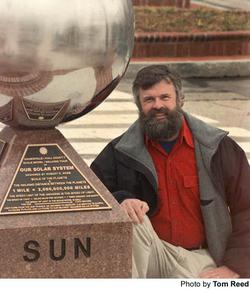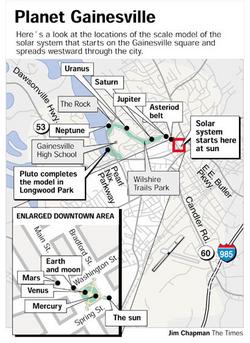 February 21, 2002 — Robert Webb told me to meet him at the planet Earth. So I did. It was cold and windy there.
February 21, 2002 — Robert Webb told me to meet him at the planet Earth. So I did. It was cold and windy there.
Turns out Earth is on the corner of Washington and Main.
You’ll find the moon there, too. Look toward the courthouse, and you’ll see the sun. It’s a stainless steel ball 27.5 inches in diameter.
Gainesville is home to one of the United States’ only walkable scale models of the solar system. It’s 1.8 miles from the sun to Pluto, which is tucked away in a far corner of Longwood Park. The rest of the planets dot a path that meanders through Rock Creek Park, Ivey Terrace Park and the Wilshire Trails system.
This universe was created in less than two years. The process began during the total eclipse of the sun — the real sun — in February 1998. Members of the North Georgia Astronomers club brought telescopes to the Gainesville Square for the occasion.
They let passers-by have a look, too. And they tried to answer their questions.
On a day when the sun and moon appeared to be identical in size, it was difficult for many to comprehend that a hollow sun would actually hold more than 64 million moons. You see, the astronomers tried to explain, the moon is only 245,000 miles away from the Earth, while the sun is 93 million miles away.
All those zeros led to some blank stares.
“We tried to figure out something we could do to try and make all of these numbers seem a little more real,” said Webb, president of the astronomy club.
So the idea for a scale model of the solar system was born.
And why not? Gainesville is already home to a bronze chicken monument and a statue of Old Joe, a Confederate soldier who really is a Rough Rider from the Spanish-American War. A few planets surely wouldn’t make things any more peculiar.
The solar system plan went through a few revisions before it came to fruition, however. At first, Webb and his group considered painting the circle that surrounds Old Joe yellow, to signify the sun.
“It seemed like a good idea,” Webb recalled. “But when we got home and got the calculator out, we found out that the next planet would be in Oakwood. Pluto would have been in Chattanooga.”
So they shrank their sun and came up with a workable, and walkable, equation: one mile on Earth equals 2 billion miles in space. It fit perfectly, from the square to Lake Lanier.
After a brief squabble with members of the local chapter of the United Daughters of the Confederacy, who didn’t want Mars and Venus encroaching on Old Joe’s personal space, the astronomers got approval for their plan. The 70-member club then became incorporated so it could accept tax-deductible donations to fund the $30,000 project.
 “It was kind of a big step for our little club,” said Webb, a boat mechanic with a bushy beard.
“It was kind of a big step for our little club,” said Webb, a boat mechanic with a bushy beard.
The Earth and moon monument was put in place Dec. 31, 1999. Several more were erected two days later. The sun came February 2001. The project was complete by April 2001.
It was a nationwide endeavor. Elberton granite was used for the monuments. Plaques were made in Virginia. Ball bearings used for some of the planets came from Connecticut. Gemstones used for other planets were shipped in from California and Oregon.
An outfit in Ohio supplied the sun — “That’s the only place I could find that would do big stainless steel hemispheres,” Webb said — which was welded together by a guy who builds dragsters in South Carolina.
The sun is by far the most noticeable of the planets in the scale model. That’s because it’s also by far the biggest. In comparison, the Earth is a quarter-inch in diameter. Mercury is the size of a nail head. An asteroid on the monument near the Hall County Library is a barely-visible speck. But it’s there. And it’s made out of an 18-thousandth ball bearing.
The speed limit of the universe is the speed of light. Webb and I broke the law. We walked to Pluto and back in about two hours.
Our starting point was the sun, whose surface has been buffed. Turns out the reflection of the real sun was blinding.
Mercury is just a few paces away. After the “Old Joe eclipse,” you’ll find Venus and the Earth and moon. And so on and so forth. Just follow the comets painted on the ground that mark the path.
Most of the planets have sponsors, some more fitting than others. For example, Venus, the only planet named after a goddess, is sponsored by Brenau Academy, the city’s private boarding school for girls. The sponsor for Mars, named for the Roman god of war, is Riverside Military Academy.
“We tried to do all the tie-ins we could,” Webb said.
I learned a lot during my celestial stroll. Like the fact that our days of the week got their names from the planets, the sun and the moon. Some — like Saturday, Sunday and Monday — are more obvious than others.
I also learned that Saturn is located really close to my house.
“No matter what age you are or how much you know about it, you get a little bit out of it each time,” Webb said. “The best feeling for me is actually seeing people use it.”
Sure enough, right around Uranus, we happened upon Paul Johnson and Jason Martin, two North Georgia College & State University students doing the solar system walk for their astronomy class.
“You get a good feel for how big things actually are by walking it off,” Johnson said.
It does really kind of put everything in perspective. We are small and insignificant, a small ball bearing floating in the vast cosmic toolbox.
When you arrive at Pluto in Longwood Park, another monument stands beside it. It directs you toward the star Alpha Centauri, the next thing you would encounter on your hike through a scale model of the universe.
But if you plan on going there, bring along your bathing suit. You won’t hit Alpha Centauri until you’re swimming in the Indian Ocean off the coast of Australia.
